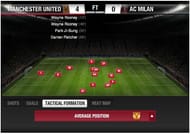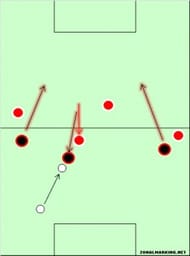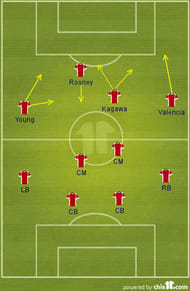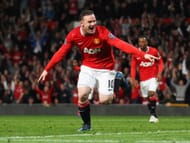In one of the highest decibel atmospheres in Basel, crowds at their feistiest of conduct saw the curtains fall on a not–so-promising European campaign in Manchester United history. The gone season will be remembered by the Mancunians for the transition the club got into but even more, for the first few sensations of vulnerability the squad encountered in almost every department of their game after a long time. The side which started with fresh blood injected with the introduction of Phil Jones, Ashley Young, David de Gea and Tom Cleverley looked a completely different outfit given by the way they played. A resounding win against Barcelona in a pre-season friendly, avoiding the early season jitters and after thrashing Arsenal 8-2, it looked that this side had announced itself like the Fergie’s Fledgings of 1995-96 season. However, there had to be a twist. The so called ‘stroll in the park’ group stage campaign turned into something increasingly daunting, as the league also started to test the mental side of the Reds. Almost a decent side of 11 players out injured, some disappointing sending-offs and terrible decision-making out of sheer panic led this United side straight to the more pragmatic end of their season’s fortunes. By the end of the year 2011, the side was looking forward to a dreadful anti-climax, dissecting the reasons of their dismal showings.
Sir Alex will have his own set of personal targets to achieve, and the prospects of another stint at the European summit being in his list cannot be discounted at all. United has won the Champions League for a couple of times in his long tenure, but it’s a trophy he would’ve liked to win more frequently and in a more dominant fashion than he has managed. The evolution of his sides is a trick that he has administered to pull off very effectively for all these years. However, it’s the inventiveness – that’s something he’s not really as competent as the other managers in his elite company. Fergie does tweak his system with the changing demands of the game, but there hasn’t been a sincere attempt to make some major changes to the overall approach of his side to tailor the needs of the European campaigns. With a trophy-less season behind us and the recruitment of Shinji Kagawa, we might be looking to a season where Sir Alex will be looking to make some radical changes to his side’s current footballing approach.
United and the 4-2-3-1 setup
Now, as the side looks ahead to a fresh beginning with some intriguing acquisitions like Shinji Kagawa and Nick Powell to the side’s ammo, United will look for some tactical makeshifts to accommodate the positional needs of their best players. As Kagawa has been promised to get a more playmaking role in the side, the side looks to employ a beefed up midfield in the better parts of the upcoming season. If United is able to pitch in a decent defensive midfield option, Ferguson may be tempted to make a permanent formation change from the traditional 4-4-2 to the more organized 4-2-3-1. Though a 4-2-3-1 would mean that it will be Rooney and Kagawa who will be the apex of all the attacks, it also clears the fact that the system will have some modifications when strikers like Welbeck or Hernandez are introduced to this setup.
On the defensive end, the revamped nature of formation will mean that United can tackle the quick break-ins more convincingly. The moments in the games with Crystal Palace, Liverpool in the Cup, Bilbao in the Europa, etc. where the United defence looks vulnerable with the full-backs getting caught upfront, a strengthened defensive midfield cover can help counter the quick counter attacks from the opposition. The beefed up central midfield has always helped United in the away games until the last season, considering United holds a record 16 games unbeaten away from home in Champions League.

March 10, 2010: Manchester United playing with a 4-2-3-1 average formation in a 4-0 home win against AC Milan.The picture shows the positional details of all United players utilized in the match.
Of course, it was the 4-5-1 which did the trick more often than not in the successful stint of 2008 and 2009. Although, one cannot deny that the average formation would always be close to a 4-2-3-1 in those matches. These methods were implemented to its very best in the 2009-10 season, when Wayne Rooney led United to a flawless season. Until, everything succumbed to an unwelcomed injury in the 1st leg of the Munich game as Rooney hurt his ankle; an injury that ended all hopes of the club to what could have been another successful season to adding only a League Cup to the trophy cabinet.
Rooney as an incandescent ‘false 9’
I can’t help but notice that whatever Rooney has played for United, the 2009-2010 season was the most fruitful one in terms of what he achieved on the field individually. Wayne has admitted the fact that he prefers playing the role behind the striker, but if the situation demands, we can see him switch for attaining some stability in the lineup. False nine is something we can directly associate to Rooney, considering his ability to play as a lone striker as well as acting as a resourceful support to his midfield and acting as a perfect layoff man for the runners exploiting the space the centre-backs create following him. This was seen at a number of occasions in the early 2010, including a 3-1 League win at Emirates and the home game against Milan, when Rooney and Co. thrashed with four goals to nothing.

The ‘false nine’ drags one centre-back out of position, leaving the other covering too large an area in the centre of the pitch.
Rooney exhibited a lot of freedom and had an instinct for movements from his teammates, as he relished a season with all the attacking responsibilities left on his shoulders. Players like this talisman thrive on such responsibilities, then why not try it again?
The invariable ‘Plan B’
In a season where we expect things to be perfectly fine, can turn out to be equally terrible- something Sir Alex witnessed firsthand in the previous season. Understandably, Sir Alex will look to device a not-too-adventurous plan B in case of things not working as expected, or as a healthy alternative in the league games. United can certainly switch back to the usual 4-4-1-1 that works so well for them in the league. The formation emphasizes the wing-play as well as works brilliantly in terms of the usual Premier League tempo. United will also be able to utilize the other established striking options of Welbeck and Hernandez in a more effective manner, something that can even prove to be vital in the event of any injuries in the campaign- something we really missed in the struggling mid-season periods.
Obviously speculations count for nothing, and as the season takes its decisive twists throughout the season, Sir Alex will look to prepare a flexible plan to utilize all the players at his disposal in an efficient way. His squad rotation techniques are commendable, while he would still look to make a couple of additions to the squad before his series of experimentation in the pre-season. Of course, the rejuvenated approach won’t be acting as a quick-fix. It will require its due time to adapt and the needed string of favourable results on implementation to survive. Though one thing is for certain- United fans can brace themselves for another promising season ahead.
Pictures courtesy: Zonal Marking, ESPN Soccernet and this11.com.



